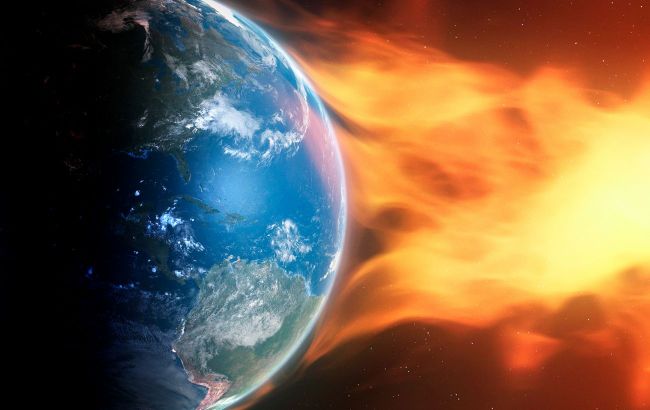Powerful solar flare alert - Biggest magnetic storm of 2025 is on its way
 A powerful magnetic storm engulfs Earth (photo: Getty Images)
A powerful magnetic storm engulfs Earth (photo: Getty Images)
A series of powerful solar flares may trigger one of the strongest magnetic storms of the year. From November 9 to 11, several major eruptions occurred on the Sun, ejecting vast clouds of plasma into space, known as coronal mass ejections, or CMEs. Here is information about the powerful high-level magnetic storm and how to protect yourself.
According to NOAA and independent monitoring services, the ejections may merge and hit Earth’s magnetic field, causing a storm rated between G1 and G4. The peak of the geomagnetic storm is most likely to occur on November 12.
Scientists say this storm could be the strongest of 2025.
What's happening: Solar cannibalism
In the past few days, the Sun has produced a series of extremely powerful X-class flares (including X1.7, X1.2, and others). These flares caused multiple plasma ejections (CMEs).
When several CMEs follow one another, they can interact in interplanetary space, intensifying each other. This effect is often referred to as solar cannibalism, resulting in a stronger geomagnetic impact when they reach Earth.
Magnetic storm forecast
NOAA warns of geomagnetic storms between November 11 and 13. Peak activity on November 12 could reach G4 (a powerful storm) or be of a lower level, depending on how the magnetic field of the plasma is oriented when it meets Earth.
Ukrainian observation portals also predict a high probability of the K-index rising to Kp-7, corresponding to strong geomagnetic activity. The storm is expected to peak in the second half of November 12 and last until 6 a.m. on November 13.
Possible effects
A strong magnetic storm can directly affect terrestrial infrastructure and human well-being. There is a risk of voltage fluctuations and even disruptions in transformer substations and power grids, especially under local loads.
Disruptions to high-frequency (HF) radio communications and GPS navigation are also possible. Navigation systems, including those used in aviation and maritime, may experience signal errors. Increased atmospheric drag could cause positioning inaccuracies or even affect the trajectories of some satellites.
There is also a higher chance of seeing bright auroras far south of their usual latitudes, including parts of Ukraine.
What is a magnetic storm?
A geomagnetic storm is Earth's magnetic field's reaction to streams of charged particles arriving from the Sun. Its intensity is measured on the Kp scale:
- Kp 4-5 is a moderate storm (G1), with possible mild discomfort
- Kp 6-7 is a strong storm (G2-G3), with possible disruptions to power grids, GPS, and communications
How magnetic storms affect people
Even moderate storms can cause:
- Headaches
- Dizziness
- Blood pressure fluctuations
- Fatigue and drowsiness
- Irritability and reduced concentration
Who is at risk
The most sensitive to geomagnetic disturbances are:
- People with cardiovascular diseases
- Those with hypertension
- Weather-sensitive individuals
- Elderly people
- Pregnant women
- Patients with chronic neurological or endocrine disorders
How weather-sensitive people can prepare
Those sensitive to weather changes should take special care. Increased sensitivity may cause headaches, overall malaise, and sleep disturbances. Individuals with cardiovascular conditions should keep their medication close and monitor their blood pressure regularly.
During peak activity days, it's recommended to avoid excessive coffee and alcohol consumption. Allow more time for rest, stay hydrated, and eat moderately.
Doctors also recommend:
- Get enough sleep (at least 7-9 hours)
- Drink plenty of water
- Include herbal teas and compotes in your diet
- Reduce caffeine intake and avoid energy drinks
- Lower stress levels, reduce psychological and physical strain
- Eat light, easily digestible, and nourishing foods such as vegetables, fruits, and fish
- Spend time outdoors and ventilate your living spaces
Practical advice
Follow updates from official sources such as NOAA Space Weather Prediction Center (SWPC), as forecasts may change in real-time.
Earlier, we named five foods that can trigger migraines.
Sources: NOAA Space Weather Prediction Center, ESA Space Weather Coordination Centre, NASA Solar Dynamics Observatory, PMC, BioMed Central, Nature.
This material is for informational purposes only and should not be used for medical diagnosis or self-treatment. Our goal is to provide readers with accurate information about symptoms, causes, and methods of detecting diseases. RBС-Ukraine is not responsible for any diagnoses that readers may make based on materials from the resource. We do not recommend self-treatment and advise consulting a doctor in case of any health concerns.

